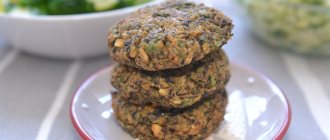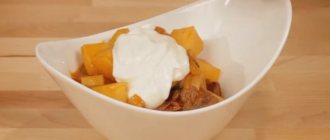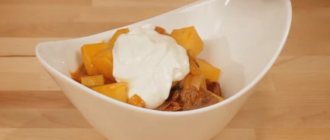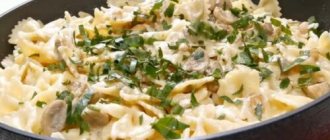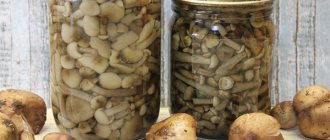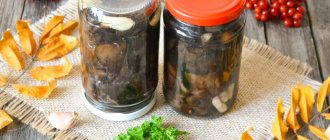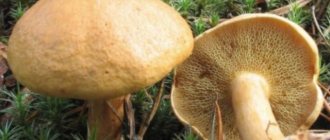4 / 5 ( 1 voice )
- earrings – 1 kg;
- vinegar - 3 tbsp. l.;
- salt – 1 tbsp. l.;
- sugar – 1.5 tbsp. l.;
- bay leaf, allspice, cloves and other spices depending on taste preferences.
How to prepare earrings for the winter:
- Place spices in water, bring to a boil and simmer over low heat for five minutes. The marinade is ready, leave it to cool.
- Peel the mushrooms and cut them in half or into quarters (if the boulders are large).
- Next, cook them for 30 minutes in salted water, skimming off the foam with a slotted spoon.
- Place spices at the bottom of pre-sterilized jars as desired, then fill the container with mushrooms and fill with cooled marinade.
- We roll up the jars with sterilized lids.
You can marinate travelers in a slightly different way - the hot method.
Hot method
Ingredients:
- mushrooms – 1 kg;
- salt – 1 tbsp. l.;
- granulated sugar – 1.5 tbsp. l.;
- vinegar - 3 tbsp. l.;
- spices: cloves, black peppercorns, bay leaf.
Preparation:
- Boil pre-soaked serushki in salted water. After boiling, cooking should be continued for 35 - 40 minutes.
- Next, remove the mushrooms from the heat and rinse under cold running water.
- Place the boiled mushrooms into the boiling marinade and boil for another 15 – 20 minutes.
- Remove from heat and immediately place in sterilized jars and fill with marinade.
- Roll up the lids.
Canning
A universal marinade recipe will help housewives preserve delicious mushrooms for the winter.
Ingredients:
- water – 1 l;
- vinegar – 100 ml;
- sugar – 100 g;
- salt – 40 g;
- spices: pepper ((battled), cloves, bay leaf, cinnamon, coriander, mustard seeds.
How to roll earrings for the winter:
- Soak and cook the mushrooms for 30 minutes. Rinse and let the liquid drain.
- Prepare the marinade: dissolve salt and sugar in water, bring to a boil.
- Add spices, vinegar and cook for another five minutes.
- Place the travelers in the marinade and continue cooking for 30 minutes.
- Place the mushrooms in jars, pour boiling marinade over them and roll up the lids.
- Cool the containers at room temperature and put them in a cool place.
Cold pickling
Salted mushrooms are an excellent ready-made snack for the winter. It is recommended to do pickling in barrels or tubs made of hardwood, but glass and enamel containers are also suitable. With the cold version of pickling, there is no need to boil the mushrooms; just soak them well, changing the water several times. After the travelers are soaked, they should be placed in layers in prepared clean containers with their caps down. Each layer must be sprinkled with salt.
Important! It is recommended to use an amount of salt of 3.5 – 4.5% relative to the weight of the mushrooms.
The bottom of the dishes for salting and the top of the last layer also need to be poured with a generous layer of salt. If desired, you can add spices between the layers to give the mushrooms a special taste. You need to put oppression on top of the laid rows of serushkas. A couple of days later, after the mass has settled, you can add a new batch of bitters. When the container is filled as much as possible, the mushrooms are filled with 6% salt solution and sealed for the winter.
As a rule, travelers are salted within 30–40 days. This method of salting makes the serushki hard and crispy. Salty wayfarers can be added to fillings and salads.
Important! It is recommended to store salted valui at a temperature of 0 to 4 degrees.
Preservation of salted earrings
Preserving salted earrings is a very convenient way to preserve tasty travelers for the winter.
Ingredients:
- mushrooms – 1 kg;
- peppercorns – 3 pcs.;
- salt – 50 g;
- bay leaf – 2 pcs.;
- garlic – 3 cloves;
- granulated sugar – 20 gr.;
- dill - 2 umbrellas.
How to prepare canned valui:
- Clean the bitters from debris, rinse, and remove the skin from the caps.
- Soak for 2 – 3 days.
- Boil in salted water for 30 minutes.
- Place the mushrooms in layers, caps down, in a wide-necked container, sprinkling each layer with salt and slices of chopped garlic.
- We are sent under oppression.
- After 15 - 20 days, put the earrings into clean jars, add dill umbrellas and slices of fresh garlic.
- Close with nylon lids. If you plan to store the products for a longer period of time, you need to sterilize the jars.
Location where they grow
Greenfinch is widespread throughout almost the entire territory of our country. She prefers light conifers, especially pine forests with sandy soil, and loves to settle in young pine forests. It can also be found in mixed forests. It usually grows in sunny places in groups of 5-8 pieces, but there are also single specimens.
Mushrooms hide in a thick layer of fallen pine needles or sand so that only their cap is visible on the surface. The value of greenfinches lies in the fact that their collection period begins in early September and lasts until early November, when almost all other mushrooms run out. They are practically not affected by worms.
We suggest you read How to cook pancakes in the oven
Serushka grows in the central zone of our country, mainly in well-lit birch or aspen groves. Loves moist soils, so it grows well after rain. Small groups of graylings can be found both at the edges and on the sides of forest roads. The collection season lasts from July to September.
Freezing
Another way to preserve mushrooms for the winter is to freeze them.
- We carry out the initial preparation of mushrooms as described above. It is not advisable to freeze valui in its raw form.
- Before freezing the travelers, they must be dried, otherwise they will turn into a piece of ice in the freezer.
- After this, the dry mushrooms are placed in plastic bags, which can be purchased at any store that sells packaging, and placed in the freezer.
Important! In the freezer, it is necessary to maintain gastronomic proximity. Frozen mushrooms are recommended to be stored for up to 6 months.
Precautionary measures
Although greenberries contain many beneficial substances, they should be consumed in small quantities. The fact is that they help thin the blood and prevent its clotting. They can also destroy the integrity of muscle cells and cause kidney failure, which can be fatal. Eating greenfinches is completely contraindicated for people with diseases of the gastrointestinal tract. Large quantities of these mushrooms eaten at the same time can cause food poisoning, accompanied by severe muscle pain and cramps.
Cold pickled mushrooms without adding vinegar
The difference between such mushrooms and salted serushkas is that you need to add sourdough. This can be whey or soft kefir.
How to make pickled earrings:
- After soaking, boil the valui in salted water (20 grams of salt per 1 liter of water) for 30 minutes.
- Preparing sourdough. To do this, you need to dissolve salt, sugar, whey or kefir in boiled water and mix well.
- The next step is to place the mushrooms in the prepared container.
- Fill the stacked bitters with sourdough and set the pressure. We remove the container to a storage place with a temperature of 5 - 10 degrees. This temperature is favorable for the fermentation process.
- After about a day, we remove the container to a cooler place (0-4 degrees) for further ripening. It will take 30-40 days.
- After fermentation, the serushki should be placed in sterilized jars, filled with boiled brine and covered with lids.
Preparing mushrooms for pickling
First of all, the earrings are carefully sorted. Rotten and worm-damaged specimens are set aside. Miniature specimens are suitable for pickling. Medium and large mushrooms can be cut into pieces, but then the dish does not look very impressive. Next, debris is carefully removed from the caps and legs.
Clean mushrooms are soaked in water for 30 minutes. Then each serushka is additionally washed under the tap. Pay special attention to the underside of the cap. Small debris always collects there. Some cooks completely remove the lamellar layer.
If wormholes are found under the plates, such mushrooms cannot be used as food.
The washed earrings are placed in a bowl. Pour in salt water and leave for 90 minutes. During this time, the bitterness inherent in mushrooms of the Russula family disappears. Before heat treatment, the water is drained.
The mushrooms are thoroughly washed under the tap and soaked again for 60 minutes. In general, the product should remain in the liquid for approximately 5 hours.
Fried earrings in glass jars
Fried mushrooms are another way to preserve the harvest and at the same time save the housewife time on cooking.
How to cook serushka mushrooms for the winter - step by step description:
- We clean, soak, and boil the earrings twice.
- If the valui are large, cut them into pieces, leave the small ones whole.
- Place in a colander to drain the water.
- Pour oil into a deep frying pan (100 ml for each kilogram of fruiting bodies) and heat it up.
- After the oil has warmed up, put the mushrooms in the frying pan . Fry, covered, for 45 minutes, stirring constantly.
- Then remove the lid and let the moisture evaporate.
- Next, you need to salt the earrings, mix and place in clean jars, pour boiling oil over them.
- Now you need to cover the jars with lids and sterilize for 15 minutes in a container with boiling water.
- Afterwards, cool the container with mushrooms and store them in a cool place.
Other names
Serushka is also found under other names.
So, in Latin it has two synonyms:
- Agaricus lactifluus flexuosus;
- Lactifluus flexuosus.
Did you know? The largest mushroom in the world, honey fungus, was discovered in Oregon. Its mycelium covers an area of 880 hectares.
Most mushroom pickers know the mushroom by the following names:
- gray hollow;
- milk mushrooms grayish-purple;
- milky gray;
- seryanka;
- sub-tree;
- plantain;
- seruha;
- putik;
- Serushka.
A simple recipe for caviar for the winter
There are many recipes for preparing dishes from travelers, one of which is spicy caviar for the winter.
Ingredients:
- earrings – 1 kg;
- carrots – 1 pc.;
- onions – 2 pcs.;
- garlic – 6 cloves;
- vinegar - 1 tbsp. l.;
- salt – 30 g;
- vegetable oil – 50 ml;
- bay leaf – 2 pcs.;
- black pepper - to taste.
Serushka caviar is prepared for the winter as follows:
- Soak the mushrooms and boil for thirty minutes in water with added salt. Repeat cooking again.
- Next, the boulders need to be transferred to a colander and allowed to drain.
- Then pass them through a meat grinder.
- Peel the vegetables. Grate the carrots on a coarse grater, cut the onion into cubes.
- Simmer the carrots and onions a little in a frying pan, and then also pass through a meat grinder.
- Mix all ingredients, add salt and spices and simmer over low heat, covering with a lid for another 15 - 20 minutes.
- Pour in vinegar. Stir the mixture and transfer it to sterilized, clean jars. Twist it.
The nutritional value
Serushka is classified as a conditionally edible mushroom of the third category of nutritional value. This means that before cooking the raw materials require additional heat treatment. The calorie content of 100 g of plant product is low - only 18.5 kcal. The same serving of mushrooms contains 1.8 g of protein, 0.8 g of fat and 1.1 g of carbohydrates.
Important! Salting mushrooms is necessary only in containers made of glass, wood or enamel. Iron (aluminum) containers are not suitable, as the product oxidizes in them.
Fruiting bodies are rich in vitamins:
- IN 1;
- AT 2;
- WITH;
- E;
- RR.
Contains minerals essential for the full functioning of the body:
- TO;
- Ca;
- Mg;
- Na;
- P;
- Fe.
They also contain a large amount of saturated, monounsaturated and polyunsaturated fatty acids.
Secrets, spices, additives...
Housewives use all kinds of spices to marinate, salt and prepare various mushroom dishes. When preparing travelers, in addition to salt, sugar and vinegar, seasonings such as pepper, black currant leaves, and cloves are well suited. You can use other spices and herbs, it all depends on your taste preferences.
Serushki have a unique chemical composition that helps improve brain nutrition, enhance the body’s immune properties, remove heavy metals and salts, and strengthen blood vessels.
The row is gray. TOP 6 edible rows that you need to know in person. Frequently
Separate row
Hello, friends!
You can bring home a full basket of mushrooms even in October, when there are no traces of noble mushrooms. The rows will help you in this good endeavor!
Gray row (striated row, pine, mouse) Tricholoma portentosum.
This is a late mushroom, it grows in large groups in pine and spruce forests, and you can get a decent amount of it. Sometimes you come to the forest, well, well, there are more mushroom pickers than mushrooms. And the gray rows stand, don’t touch them, I quickly put their little ones in the basket. Good marinated, salted, in soup, or roast. Delicious mushroom!
The row is gray. Photo by the author.
The row is gray. Photo by the author.
Violet row (lepista violet, cyanosis) Lepista nuda.
Late autumn mushroom grows in huge rings and rows. You can fill a whole basket with one ring. If we consider that it grows late, when there are no traces of noble mushrooms, then this mushroom has no price
In the southern regions they know it and take it, but in our country they treat it with caution. But in vain
The roast turns out delicious!
The row is purple. Photo by the author.
The row is purple. Photo by the author.
Blue-legged rower Lepista saeva.
Grows in moist deciduous forests, near pastures from mid-spring to late autumn in large groups. Scares off mushroom pickers with its blue leg. Mushroom of the 4th category. Experienced mushroom pickers find the taste of this mushroom similar to that of champignons. A tasty mushroom with tender flesh and a pleasant fruity aroma. Salted, fried, pickled.
Lilac-legged row. Photo Yandex. Images.
Poplar row (poplar) Tricholoma populinum.
One of the last autumn mushrooms. Loves poplar plantings and has a peculiar floury smell. It goes into salting and does not change color during processing. Good when salted, pickled or roasted.
Poplar row. Photo Yandex. Images.
Greenfinch (Tricholoma flavovirens)
Greenfinch grows in small groups, families in coniferous forests, loves sandy soils. Almost never wormy. Maybe because it is a late mushroom, and there are already very few insects. These mushrooms are very tasty when salted. The taste of greenberries is simply excellent!
Greenfinch. Photo by the author.
Greenfinch. Photo by the author.
Smoky row (smoky talker) Clitocybe nebularis.
Grows in large groups. It’s very good when salted, especially young ones (unopened mushrooms) - fleshy, plump, and don’t fall apart. Delicately sweet taste, few worms, grows in large groups - some advantages!
The row is smoky. Photo by the author.
The row is smoky. Photo by the author.
What they look like
Volnushki belong to the genus of laticifers, the Russula family. These are lamellar, conditionally edible mushrooms, which must be thoroughly processed (soaked, boiled) before cooking. There are several types of wavefish: white (Lactárius pubéscens), pink (Lactárius torminósus), marsh or black milky (Lactárius viétus). Very often, mushroom pickers call the real milk mushroom a volushka, but in fact it is an ordinary pink volushka.
Description of pink wave
This fungus can be called: volnyanka, volnovukha, volzhanka, volvenka, volvyanitsa, volminka, rubella, krasulya, decoction. The Latin name is Lactarius torminosus.
The cap has a size from 4 to 12 centimeters; in young fruiting bodies it is convex, and flattens as it grows. In the center you can see the umbilical cavity (funnel), the edges of the cap are lowered. The skin is slightly slimy and has coarse villi arranged in uneven circles. The color of the hat is gray-pink or pale pink, darkens when pressed. If the fruit body grows in dry places, then the color of the cap turns pale and fades.
When cut, the pulp has a dense structure, it is strong and snow-white. The taste is spicy. The milky juice is also white, sharp, and is released very abundantly when the body is broken.
The hymenophore (bottom layer of the cap) is a whitish plate with a pink tint, which turns yellow over time. They are not wide, often located, descending along the leg. Between them there are intermediate plates. The spore powder is creamy white or white.
The leg is cylindrical, strong, hard, tapering towards the base. In young specimens this part is solid, but becomes hollow with age. The color is pale pink, the surface is covered with fluff and small depressions.
Jacob Christian Schaeffer was the first to describe the pink trumpet in 1774, and in 1797 he assigned the binomial name to this species - Lactarius torminosus.
Compound
The composition of the waves includes:
- proteins (3%),
- fats (0.5%),
- carbohydrates (1.7%),
- dietary fiber (5.5%)
- water (89%).
In turn, fats contain organic acids, including lactic, acetic and oleic. Carbohydrates are found in fibers mainly as fiber, which contains chitin. When it enters the human body, chitin binds lipids and prevents the absorption of fats. As a result, cholesterol levels become lower. But chitin can cause allergies in those who react to shellfish, and can even make it harder to digest food, even blocking the digestive system
Therefore, despite the fact that chitin is beneficial for the human body, people with gastrointestinal problems should be wary of consuming it. Volnushki are rich in vitamins such as: A, B1, B2, E, C, PP, etc.
These mushrooms contain eighteen types of amino acids, as well as biologically active substances, glutamic and aspartic acids.
Despite the fact that the calorie content of volnushki is only 22 kcal per 100 g, they quickly satisfy hunger and give a feeling of fullness, which is why their consumption helps fight excess weight. In patients with diabetes, glucose levels are stabilized, cholesterol is reduced, and blood vessels are cleansed and strengthened.
Biologically active substances found in volnushki help improve the condition of the skin and hair, and also help strengthen the immune system. In addition, heart rate and blood pressure normalize, and blood flow improves. Regular consumption of volushki helps improve brain function, correct vision problems, has a good effect on blood vessels, joints, and the nervous system, and can prevent the development of hypertension and even oncology.
But if you neglect the pre-treatment of these mushrooms, you can easily get food poisoning with consequences in the form of nausea, dizziness, etc.
Differences between edible earrings and their poisonous counterparts
Very often, real earrings can be confused with false or poisonous ones, which can harm human health. Representatives of the rower species are most similar to the white earrings. Poisonous rows include white, soap, sulfur, mouse and tiger. In order not to be poisoned by poisonous rows, you need to know some features of their appearance:
- Young white rower has a white or milky color, which becomes darker with age. The leopard print looks like a white one, since the surface of its cap is covered with large brown spots. The rows, whose caps are very similar in shape to the earrings, have a dirty yellow color and are also prohibited from being eaten.
White row Soap row has olive-colored caps and a spotted stem. This subspecies is not poisonous, but has been classified as inedible, which is due to its soap-like appearance after heat treatment.
Soapy row
The pulp of all rows is distinguished by its pungent, strong odor. The leg is mostly dark grey. False rows grow mainly in subclay and subsandy substrates.
Characteristic features of the variety
Mushrooms belong to the genus Mlechnik and the family Russula
In order not to leave an inconspicuous mushroom unnoticed and to distinguish it from others, it is necessary to pay attention to its morphological features. Photos and descriptions of serushka mushrooms are presented below
Other names for serushki
Serushki have a large number of other names. Among them:
- purple milk mushroom;
- serukha or seryanka;
- gray nest;
- laticifer gray or gray-purple;
- subordium or plantain;
- greenfinch;
- putik;
- gray row;
- bitter.
The gray rower differs from other types of milkweed by its sparsely located yellow plates and milky sap, which do not change color in the air.
Appearance and photo
It is very important to remember what a mushroom looks like, then distinguishing it from other species will not be difficult even for inexperienced and novice mushroom pickers. The appearance corresponds to the name of the mushroom, since most often the mushroom cap has a grayish color
However, sometimes there are specimens with a faint pink, pale purple or bright brown color. The fruiting body of earrings reaches small sizes, and also very often merges with the ground and leaves.
Morphology
Greenfinches have the following species characteristics:
- The mushroom cap can reach 10 cm in diameter. In the center of the cap there is a small tubercle, which smoothly turns into a funnel-shaped shape, the edges are convex, curved into the middle, wavy. The surface relief includes concentric and flat parts. Color may vary. The lamellar part is represented by sparsely spaced tortuous plates, initially straight and adherent to the stalk. The predominant color is light yellow.
Serushka Lactarius flexuosus
The spores are small, spherical in shape and yellow in color, with an ornament. The spore powder is also yellow. The leg is massive, up to 2 cm wide and 8-10 cm high. The consistency is dense, there is a cavity inside. It is cylindrical in shape, with longitudinal grooves on the surface. The color matches the color of the cap or is slightly lighter. The consistency of the pulp is dense, soft, has a pleasant aroma, and from a distance it looks like fruit. Juice. When cut, a white milky juice with a pungent taste is released from the fruiting body. It does not oxidize in air and does not change color.
Place of distribution
Most often distributed in mixed or deciduous forests. The most comfortable conditions for growth are observed in thickets of birch or aspen trees, since the area there is well lit and the upper layers of the soil are always warm. Purple milk mushrooms also love swampy places, so after heavy autumn rains their increased growth is observed.
Peak yield occurs at the beginning of July and lasts until the end of autumn. This variety grows in virtually all regions. The mushroom can be found in all countries of Europe and Asia. Particularly common in Siberia and the northern part of Russia. The most comfortable climate is considered moderate. They grow mainly in groups.
Eating
When collecting mushrooms, you must be able to distinguish the edible species from the poisonous ones. The greenfinches themselves do not pose a threat to human life and belong to the conditionally edible type due to the presence of caustic white juice inside.
Answers to common questions
Questions about the preparation, benefits, calorie content and cooking of earrings are the most common:
Serushki are mushrooms widespread in Russia, which are often used by people in cooking and are of particular value in folk medicine. It is quite easy to distinguish them from their inedible counterparts, but if in doubt, it is better to leave the mushroom in the forest.
[pp_youtube src=”https://www.youtube.com/embed/Uf9 >
But experienced supporters of “silent hunting” will never pass by the small grayish hats of these gifts of the forest.
Let's take a closer look at the botanical features of the sulfur row , its distribution areas, as well as the secrets of its use in cooking.
Useful properties and calorie content of putiki
Serushki are nutritious and high-calorie mushrooms (185 Kcal per 100 g of product).
Thanks to the rich chemical composition, which contains amino acids, fiber, vitamins, minerals, travelers are very useful. Useful properties of putik:
- Helps strengthen the walls of blood vessels, making them more elastic. At the same time, the nerve sheath is strengthened and thought processes are improved.
- Activate the production of collagen and protein. Thanks to this, the condition of the skin improves, it becomes more elastic, and the regeneration processes of damaged areas are accelerated.
- They improve the functioning of the gastrointestinal tract thanks to some components in mushrooms that remove toxins.
- Burning extra calories - mushrooms speed up metabolism, normalize the microflora of the gastrointestinal tract, and stabilize peristalsis.
- Strengthen the immune system: consumption of earrings leads to the production of antibodies that cope with infectious and fungal agents and cleanse the blood.
In addition, eating properly prepared mushrooms will help get rid of worms, relieve emotional stress, and normalize insulin levels in the blood, which is especially important for those who suffer from diabetes.
However, it is not recommended to mindlessly consume mushrooms in large quantities. This may cause:
- Food poisoning as a result of exceeding dosages of chitin, which is contained in earrings. Characterized by nausea, vomiting, pain, fever, and migraine.
- Development of an allergic reaction, manifested by itching, severe cough, redness of the skin.
- Inflammation of the rectum and duodenum. Symptoms: aching joints, abdominal pain, pressure changes.
During pregnancy, with bacterial vaginosis, dropsy, you should not consume any dishes made from sulfur, as this can cause deterioration in your health.



